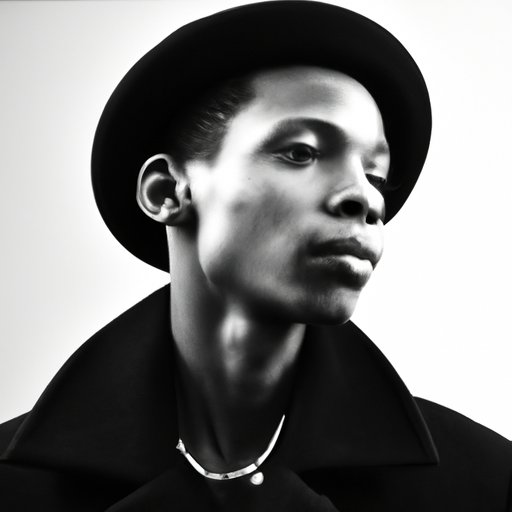Introduction
A portrait in photography is a representation of a person or group of people that captures their likeness, personality, and even mood. It is an art form that has been practiced since the invention of the camera, and it is still a popular form of expression today. In this article, we will explore what a portrait is in photography, the different types of portraits, and how to create stunning portraits.
A Guide to Portrait Photography: What is a Portrait?
The goal of a portrait is to capture the essence of the subject, whether it be a single person or a group of people. This can be done through traditional poses, candid shots, environmental portraits, action/sports portraits, or even self-portraits. It is important to understand the purpose of each type of portrait before embarking on a portrait session.

Exploring the Art of Portraiture in Photography
Portraiture has been around for centuries, ever since the invention of the camera. While the techniques have changed over time, the goal remains the same: to capture the uniqueness of the subject in an artistic way. Through portraiture, photographers are able to tell stories, evoke emotion, and create lasting memories.
Capturing the Essence of People
When creating a portrait, it is important to focus on capturing the essence of the person or people you’re photographing. This means focusing on their unique features, expressions, and body language. It also means capturing the environment they’re in and any meaningful props or objects that may be present. By doing this, you can create a portrait that truly reflects the person or people being photographed.

Types of Portraits in Photography and How to Achieve Them
There are several different types of portraits in photography, each with its own specific goals and techniques. Below, we will explore the different types of portraits and how to achieve them.
Traditional Portraits
Traditional portraits are posed images of one or more people. This type of portrait typically involves the photographer directing the subject to look a certain way, move a certain way, or hold a certain pose. It is important to remember that while posing can help create a desired effect, it should not take away from the natural beauty of the subject.
Candid Portraits
Candid portraits capture moments as they happen, without any direction from the photographer. This type of portrait allows the photographer to capture the subject in their natural state, which can often result in more meaningful images. Candid portraits are often used to document events or everyday life.
Environmental Portraits
Environmental portraits are those that are taken in the subject’s natural environment. This could be at home, at work, or out in nature. The goal of this type of portrait is to capture the subject in their most comfortable environment and to tell a story about their life.
Action/Sports Portraits
Action or sports portraits are photographs that capture the subject in motion. This type of portrait requires the photographer to be quick and creative in order to capture the perfect moment. It is important to choose the right lens and settings to ensure the best results.
Self-Portraits
Self-portraits are photographs that are taken by the subject themselves. This type of portrait allows the subject to express themselves in a creative and unique way. Self-portraits can be used to document personal growth, celebrate accomplishments, or simply to share a part of yourself with the world.

An Introduction to the World of Portrait Photography
Now that we have explored the different types of portraits in photography, let’s take a look at the equipment and techniques needed to capture stunning portraits.
Equipment Needed for Portrait Photography
The equipment needed for portrait photography varies depending on the type of portrait you are trying to achieve. For traditional portraits, a DSLR camera with a variety of lenses is recommended. For candid and environmental portraits, a mirrorless camera with a wide angle lens is ideal. For action or sports portraits, a telephoto lens is essential. Additionally, a tripod and external flash are helpful for achieving the best results.
Tips for Taking Great Portraits
Taking great portraits takes practice and patience. Here are some tips to help you get started:
- Get to know your subject – Spend time getting to know the person or people you’re photographing. This will help you capture their essence and create a more meaningful portrait.
- Choose the right light – Natural light is usually best for portraits, but you can also experiment with artificial light sources such as studio lights or flashes.
- Focus on the eyes – Eyes are the windows to the soul, so make sure to focus on them when taking a portrait.
- Be creative – Try different angles, poses, and perspectives to create unique and interesting portraits.
Editing Your Portraits
Once you have taken your portraits, it is time to edit them. There are many photo editing software programs available, such as Adobe Photoshop or Lightroom. These programs allow you to adjust the color, contrast, sharpness, and other aspects of your photos to create stunning images.
Conclusion
Portrait photography is an art form that has been around for centuries. It is a way to capture the uniqueness of a person or group of people and tell their story. There are many different types of portraits that can be achieved, each with its own set of techniques and equipment. With practice and patience, anyone can learn to take stunning portraits.
(Note: Is this article not meeting your expectations? Do you have knowledge or insights to share? Unlock new opportunities and expand your reach by joining our authors team. Click Registration to join us and share your expertise with our readers.)
